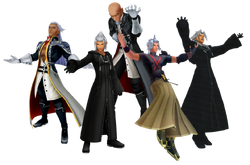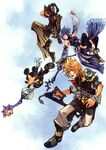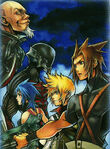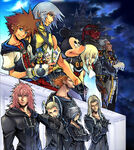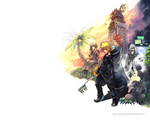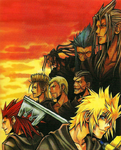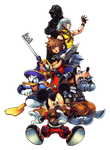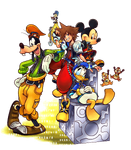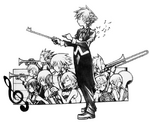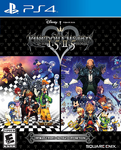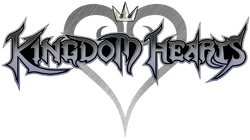Kingdom Hearts (キングダム ハーツ Kingudamu Hātsu) is a fantasy action role-playing video games franchise developed and published by Square Enix (formerly Square). It is the result of a collaboration between Square Enix and Disney Interactive Studios and is under the direction of Tetsuya Nomura, a longtime Square character designer. Kingdom Hearts is a crossover of various Disney settings based in a universe made specifically for the series.
Also, it has an all-star voice cast which includes many of the Disney characters' official voice actors, and well-known voice actors, such as Haley Joel Osment, David Gallagher, and Hayden Panettiere. The series' plot centers on the main character Sora's search for his friends and his encounters with Disney, Final Fantasy, and The World Ends With You characters on their worlds.
The series currently consists of seven games across multiple video game consoles, and future titles are already planned. Most of the games in the series have been both critically acclaimed and commercially successful, though each title has seen varying levels of success. As of March 2011, the Kingdom Hearts series has sold over 17 million copies worldwide. A wide variety of related merchandise has been released along with the games, including soundtracks, figurines, companion books, novels, and manga.
Titles
| Game | Release Date (Japan: Original) | Release Date (USA: English Adaptation) | Original Platform | Release Order |
|---|---|---|---|---|
| Kingdom Hearts | March 28, 2002 (PS2); March 14, 2013 (PS3); March 9, 2017 (PS4); February 18, 2020 (Xbox One), March 30, 2021 (PC); February 10, 2022 (Nintendo Switch), June 13, 2024 (Steam) | September 17, 2002 (PS2); September 10, 2013 (PS3); March 28, 2017 (PS4), February 18, 2020 (Xbox One), March 30, 2021 (PC); February 10, 2022 (Nintendo Switch), June 13, 2024 (Steam) | PlayStation 2 | 1st part |
| Kingdom Hearts: Chain of Memories | November 11, 2004 (GBA); March 29, 2007 (PS2), March 14, 2013 (PS3); March 9, 2017 (PS4); February 18, 2020 (Xbox One), March 30, 2021 (PC); February 10, 2022 (Nintendo Switch), June 13, 2024 (Steam) | December 7, 2004 (GBA); December 2, 2008 (PS2), September 10, 2013 (PS3); March 28, 2017 (PS4); February 18, 2020 (Xbox One), March 30, 2021 (PC); February 10, 2022 (Nintendo Switch), June 13, 2024 (Steam) | Game Boy Advance | 2nd part |
| Kingdom Hearts II | December 22, 2005 (PS2); October 2, 2014 (PS3); March 9, 2017 (PS4); February 18, 2020 (Xbox One), March 30, 2021 (PC); February 10, 2022 (Nintendo Switch), June 13, 2024 (Steam) | March 28, 2006 (PS2); December 2, 2014 (PS3); March 28, 2017 (PS4); February 18, 2020 (Xbox One); March 30, 2021 (PC), February 10, 2022 (Nintendo Switch), June 13, 2024 (Steam) | PlayStation 2 | 3rd part |
| Kingdom Hearts 358/2 Days | May 30, 2009 (DS); March 14, 2013 (PS3); March 9, 2017 (PS4); February 18, 2020 (Xbox One), March 30, 2021 (PC); February 10, 2022 (Nintendo Switch), June 13, 2024 (Steam) | September 29, 2009 (DS); September 10, 2013 (PS3); March 28, 2017 (PS4); February 18, 2020 (Xbox One), March 30, 2021 (PC); February 10, 2022 (Nintendo Switch), June 13, 2024 (Steam) | Nintendo DS | 4th part |
| Kingdom Hearts: Birth by Sleep | January 9, 2010 (PSP); October 2, 2014 (PS3); March 9, 2017 (PS4); February 18, 2020 (Xbox One), March 30, 2021 (PC); February 10, 2022 (Nintendo Switch), June 13, 2024 (Steam) | September 7, 2010 (PSP); December 2, 2014 (PS3); March 28, 2017 (PS4); February 18, 2020 (Xbox One), March 30, 2021 (PC); February 10, 2022 (Nintendo Switch), June 13, 2024 (Steam) | PSP | 5th part |
| Kingdom Hearts coded | November 18, 2008-January 28, 2010 (DoCoMo); October 7, 2010 (DS), October 2, 2014 (PS3); March 9, 2017 (PS4), February 18, 2020 (Xbox One), March 30, 2021 (PC); February 10, 2022 (Nintendo Switch), June 13, 2024 (Steam) | January 11, 2011 (DS); December 2, 2014 (PS3); March 28, 2017 (PS4); February 18, 2020 (Xbox One), March 30, 2021 (PC); February 10, 2022 (Nintendo Switch), June 13, 2024 (Steam) | NTT DoCoMo | 6th part |
| Kingdom Hearts 3D: Dream Drop Distance | March 29, 2012 (3DS); January 12, 2017 (PS4); February 18, 2020 (Xbox One), March 30, 2021 (PC); February 10, 2022 (Nintendo Switch) | July 31, 2012 (3DS); January 24, 2017 (PS4); February 18, 2020 (Xbox One), March 30, 2021 (PC); February 10, 2022 (Nintendo Switch) | Nintendo 3DS | 7th part |
| Kingdom Hearts χ | July 18, 2013 (PC) | n/a | PC | 8th part |
| Kingdom Hearts Unchained χ | September 3, 2015 (iOS)/(Android) | April 7, 2016 (iOS)/(Android) | iOS, Android | 8th/9th part |
| Kingdom Hearts HD II.8 Final Chapter Prologue | January 12, 2017 (PS4); February 18, 2020 (Xbox One), March 30, 2021 (PC); February 10, 2022 (Nintendo Switch), June 13, 2024 (Steam) | January 24, 2017 (PS4); February 18, 2020 (Xbox One), March 30, 2021 (PC); February 10, 2022 (Nintendo Switch), June 13, 2024 (Steam) | PS4 | 10th part |
| Kingdom Hearts Union χ | March 23 2017 (iOS/Android) | April 6 2017 (iOS/Android) | iOS, Android | 11th part |
| Kingdom Hearts III | January 25, 2019 (PS4)/(Xbox One); March 30, 2021 (PC), June 13, 2024 (Steam) | January 29, 2019 (PS4)/(Xbox One); March 30, 2021 (PC), June 13, 2024 (Steam) | PS4, Xbox One | 12th part |
| Kingdom Hearts: Melody of Memory | November 11, 2020 (PS4)/(Xbox One)/(Nintendo Switch), March 30, 2021 (PC); February 10, 2022 (Nintendo Switch) | November 13, 2020 (PS4)/(Xbox One)/(Nintendo Switch), March 30, 2021 (PC); February 10, 2022 (Nintendo Switch) | PS4, Xbox One, Nintendo Switch | 13th part |
The three main games in the series were released in chronological order, with each new installment following the events of the previous installment. The one exception is the V CAST mobile game, which was developed independently of Square Enix's games.
Games
Kingdom Hearts is the first game in the series, released in Japan on March 28, 2002 for PlayStation 2. Tetsuya Nomura served as game director, his first time in this position. Kingdom Hearts introduced the main characters of the series and established the plot's framework, involving hearts and dark beings known as the Heartless. It also established the role of Disney characters in the series, with character cameos from the Final Fantasy series. Kingdom Hearts was released in North America on September 17, 2002, and featured additional content that was not in the original Japanese version. The game was later re-released exclusively in Japan as Kingdom Hearts Final Mix on December 26, 2002. Final Mix includes the content from the North American release and additional enemies, cutscenes, and weapons. The Final Mix version was remastered on March 14, 2013 (Japan), and on September 10, 2013 (North America) known as Kingdom Hearts HD 1.5 ReMIX for the (PS3).
Kingdom Hearts: Chain of Memories is a direct sequel to the first game. It was released on the Game Boy Advance in Japan on November 11, 2004. Chain of Memories was touted as a bridge between Kingdom Hearts and Kingdom Hearts II, introducing and previewing plot elements that would be explored in the next game. The gameplay system is a departure from the original, employing card game mechanics in real-time. Players construct decks out of cards that correspond to different actions in battle, such as attacking or using magic. It was remade into a PlayStation 2 game titled Kingdom Hearts: Chain of Memories, which contains polygon graphics instead of the sprites used in the original game. The remake was released in Japan as a second disc packaged with Kingdom Hearts II Final Mix on March 29, 2007, and in North America as a standalone title on December 2, 2008.
Kingdom Hearts II takes place one year after the events of Chain of Memories. It was released for the PlayStation 2 in Japan on December 22, 2005. The game further explores the "heart" concept by involving a new group of enemies, the Nobodies, which are the cast-off shells of the Heartless. The gameplay is similar to that of the first Kingdom Hearts game, with the addition of the Reaction Command, which performs context-sensitive actions in battle. Kingdom Hearts II was revised into Kingdom Hearts II Final Mix, which contains more material than the original release, such as additional cutscenes and bosses. Kingdom Hearts II Final Mix was released with Kingdom Hearts Re:Chain of Memories in a collection titled Kingdom Hearts II Final Mix+, which was released in Japan on March 29, 2007. The Final Mix version was later remastered and re-released as part of Kingdom Hearts HD II.5 ReMIX.
Kingdom Hearts 358/2 Days was released for the Nintendo DS in Japan on May 30, 2009. It is primarily set between Kingdom Hearts and Kingdom Hearts II, focusing on Roxas' time in Organization XIII and his motives for leaving. It is the first game in the series to feature cooperative gameplay in addition to the traditional use of AI-controlled partners. The gameplay is mission-based with optional objectives that yield additional rewards. The game also has a unique panel system that governs character improvement, special abilities, and equipped weapons.
Kingdom Hearts: Birth by Sleep is a prequel to the series, released for the PlayStation Portable in Japan on January 9, 2010, and in North America on September 7, 2010 with additional content. The game is set ten years before the events of the first Kingdom Hearts game, revealing the origins of the villain, Xehanort. It consists of four scenarios, three of which focus on one of the game's three protagonists—Terra, Ventus, and Aqua—and the fourth unlocked upon completion of the first three. The game was re-released exclusively in Japan under the title Kingdom Hearts Birth by Sleep Final Mix on January 20, 2011 with the content from the English versions as well as new features, such as an additional fifth scenario. The Final Mix version was later remastered and re-released as part of Kingdom Hearts HD II.5 ReMIX.
Kingdom Hearts coded is an episodic mobile phone game that picks up directly after Kingdom Hearts II. The "preinstall" episode was released exclusively in Japan on November 18, 2008 and eight episodes were released between June 3, 2009 and January 28, 2010. The game was remade for the Nintendo DS as Kingdom Hearts Re:coded, and features updated gameplay combining that of two later titles in the series, 358/2 Days and Birth by Sleep. Unlike the original version, Re:coded was released internationally: October 7, 2010 in Japan; January 11, 2011 in North America; and January 14, 2011 in Europe.
Kingdom Hearts 3D: Dream Drop Distance was released on March 29, 2012 in Japan for the Nintendo 3DS. The game focuses on Sora and Riku Mark of Mastery exam under Yen Sid in anticipation of Master Xehanort's return and their subsequent conflicts with enemies from their past. In addition to similar systems inherited from Birth by Sleep, this game features Dream Eaters which serve as both enemies and allies. Players may collect and breed friendly Dream Eaters and train them to become more powerful. The English edition was released on July 20, 2012 in the United Kingdom and on July 31, 2012 in the United States.
Kingdom Hearts III was released on January 25, 2019 in Japan for the Xbox one and the PS4. In Kingdom Hearts III, the series protagonist Sora is on the search for the "Key to Return Hearts" while Sora's friends, Riku and King Mickey, search for Keyblade wielders. This game featured new combat abilities and gameplay, with multiple features from previous titles. The game concluded the "Xehanort Saga", but it will not be the final game in the series. The English version was released in the United States on January 29, 2019. A PC Port and Nintendo Switch cloud-based port was later created and released on March 30, 2021 worldwide for the PC version and February 10, 2022 for the Nintendo Switch version which also included all the DLC from the original release.
Kingdom Hearts: Melody of Memory was released on November 11, 2020 in Japan for the PS4, Xbox One, and Nintendo Switch. The game take places after the events of ReMind where Kairi is the main focus. The game will remove combat in favor of rhythm-style gameplay, making the player take control of four separate three-man teams that each represents a previous Kingdom Hearts title. Each Disney world will feature its own Disney character as the player's ally. The English version was released in the United States on November 13, 2020. A PC Port was later created and released on March 30, 2021 worldwide.
Mobile
A Kingdom Hearts game was developed exclusively for V CAST, Verizon Wireless's broadband service, and was released on October 1, 2004 in Japan and on February 4, 2005 in the United States. It was one of the launch games for the V CAST services. The game, developed by Superscape and published by Disney Mobile with no involvement from Square Enix, features gameplay akin to the first Kingdom Hearts game, modified for the input method of mobile phones. The game's storyline features Sora struggling to free himself from a nightmare induced by Maleficent's magic.
Kingdom Hearts Mobile is a Kingdom Hearts-themed social game in which players can play mini-games together. Unlike Kingdom Hearts for the V CAST and Kingdom Hearts coded, this game does not have a storyline and focuses more on socializing. The service operates in conjunction with Kingdom Hearts coded—new avatar costumes become available after the player completes an episode of Kingdom Hearts coded. Kingdom Hearts-related media such as wallpapers, ringtones, graphics, and other items can be purchased and downloaded through the service for mobile phones.
Kingdom Hearts Union χ, formerly known as Kingdom Hearts Unchained χ, is a rerelease and sequel to the Japanese exclusive Kingdom Hearts χ, an online browser game for PC. It was announced at the Square Enix E3 2015 press conference, releasing exclusively for iOS and Android mobile devices. The Kingdom Hearts χ series is the first in the Kingdom Hearts series to adopt a new artistic style for the series, by opting for a two dimensional, Chibi-like storybook visual as opposed to the standardized polygonal, cel-shaded Kingdom Hearts engine for console and handhelds. The story is based in the most distantly canonical past of the Kingdom Hearts timeline, during the age of the Keyblade War known as the "Age of Fairytales". You create a customized player character that has the option of choosing one of five factions (Unicornis, Anguis, Leopardos, Vulpeus, and Ursus) that are tasked to gather light (Lux) from various Disney worlds and protect these worlds from the darkness.
Kingdom Hearts Dark Road: Dark Road is a mobile game that was added to the Union χ app on June 22, 2020. Since the two games were added together, the app was rebranded as Kingdom Heart Union χ Dark Road to commemorate its release. It details Xehanort's life before he became a Master and what made him side with darkness. It also reveals mysteries about the worlds.
Collections
Kingdom Hearts HD I.5 ReMIX was released for the PlayStation 3 in Japan on March 14, 2013. The collection includes a remastered version of Kingdom Hearts Final Mix and Re:Chain of Memories, which include gameplay enhancements and trophy supports. Also, a "Theatre Mode" has been created, consisting of high definition cutscenes from Kingdom Hearts 358/2 Days. The collection was released in North America on September 10, 2013, in Australia on September 12, 2013, and in Europe on September 13, 2013.
Kingdom Hearts HD II.5 ReMIX: During the closing credits of Kingdom Hearts HD 1.5 Remix, videos of Kingdom Hearts II Final Mix, Kingdom Hearts Birth by Sleep Final Mix, and Kingdom Hearts Re:coded are shown in HD, implying a second compilation. Nomura himself has admitted that it would be "pretty unnatural" for there not to be a 2.5 after 1.5. On October 14, 2013, the collection was announced to include the previously mentioned games, with Re:coded appearing as HD cinematics, similar to 358/2 Days in HD 1.5 Remix. The collection was released globally in 2014, exclusively for the PlayStation 3. The release dates were October 2, 2014 in Japan, North America on December 2, 2014, and in Europe on December 5, 2014.
Kingdom Hearts HD II.8 Final Chapter Prologue: The Last HD Collection to be released, after I.5 and II.5. It contains an HD Port of Dream Drop Distance called Kingdom Hearts HD: Dream Drop Distance, an alternate cinematic telling of Kingdom Hearts χ called Kingdom Hearts χ Back Cover, and an all-new playable 'episode' titled Kingdom Hearts 0.2 Birth by Sleep: A Fragmentary Passage, which serves as a sequel to Kingdom Hearts Birth by Sleep, and a prequel to Kingdom Hearts III. This is the only HD Collection that is being made exclusively for the PlayStation 4 as Kingdom Hearts HD: Dream Drop Distance dual-screen gameplay can only be replicated to a singular screen using the PlayStation 4, and because Kingdom Hearts χ Back Cover and Kingdom Hearts 0.2 Birth by Sleep: A Fragmentary Passage is using the Unreal 4 engine present in Kingdom Hearts III which is only capable with current generation consoles. The game was released in Japan on January 12, 2017 in Japan and the rest of the world on January 24, 2017. Three additional ports were later released worldwide, first on February 18, 2020 for the Xbox One, on March 30, 2021 for the PC, and lastly February 10, 2022, for the cloud-based Nintendo Switch version.
Kingdom Hearts HD 1.5 + 2.5 ReMIX: A compilation game consisting of Kingdom Hearts HD I.5 ReMIX and Kingdom Hearts HD II.5 ReMIX that was released on the Playstation 4 in March 2017. Unlike the original PS3 combo pack, it was only released on one disc. The game was released on March 9, 2017 in Japan, March 28, 2017 in North America and March 31 2017 in Europe. Additionally, for the PS4 release, both games much like with Kingdom Hearts HD II.8 Final Chapter Prologue, are also run at 60 fps and also include several other improvements, including free DLC, a first for the series. Three additional ports were later released worldwide, first on February 18, 2020 for the Xbox One, on March 30, 2021 for the PC, and lastly February 10, 2022, for the cloud-based Nintendo Switch version with all the DLC from the PS4 version included in these versions as part of the release.
Kingdom Hearts: The Story So Far: A two-disc combo pack for the PS4 that has both of the previous PS4 releases of Kingdom Hearts HD 1.5 + 2.5 ReMIX and Kingdom Hearts HD 2.8 Final Chapter Prologue re-released in a collection set. Released on October 30, 2018 in North America only.[1]
Kingdom Hearts All-In One-Package: Originally this was a digital purchase on the PlayStation Store that was released on March 27, 2019[2] that included all the current PS4 releases of Kingdom Hearts HD 1.5 + 2.5 ReMIX, Kingdom Hearts HD 2.8 Final Chapter Prologue, and Kingdom Hearts III. Was released in physical format in a three-disc set for North America on March 17, 2020.[3]
Kingdom Hearts Integrum Masterpiece: A bundle pack-based release for the Nintendo Switch cloud-based and the updoming Steam releases which contains the cloud-based versions of Kingdom Hearts HD 1.5 + 2.5 ReMIX, Kingdom Hearts HD 2.8 Final Chapter Prologue, and Kingdom Hearts III = Re: Mind, which allows all three titles to be bought simultaneously at a lesser combined price. It was releasd the same day as the Switch releases for these three games February 10, 2022, with the Steam version currently planned for release on June 13, 2024.
Common Gameplay Elements
- Main article: Gameplay in Kingdom Hearts
The Kingdom Hearts series games contain elements from both action and role-playing games. The games are driven by a linear progression to the next story event, usually told in the form of a cut scene, though there are numerous side quests available that provide bonus benefits to the characters. The player is primarily in control of the principal protagonist of the series, Sora. Sora is usually accompanied by Donald Duck and Goofy, who are non-playable characters that aid Sora in battle. In the first and third games, their behavior could be altered to fit the player's needs. The games featured real-time combat that incorporates physical attacks, magic, and summons; though each game handled battles differently.
Gummi Ships are another common theme in the series, though they are only featured in the first and third installments. The Gummi Ships serve as the main mode of transportation between worlds in the games. The gameplay for the Gummi Ships sections is more akin to a rail shooter. Because it received negative criticism in the first game, it was improved in the third installment. All three games also feature a journal that is accessible from the main menu. The journal keeps track of information regarding the story, characters, enemies, and locations. In the game, the journal is kept by Jiminy Cricket, who was appointed by Queen Minnie as the royal chronicler.
The games are influenced by their sister franchise, Final Fantasy, and carry its gameplay elements over into their own action-based, hack-and-slash system. Like many traditional role-playing games, Kingdom Hearts features an experience point system that determines character development. As enemies are defeated, the player gains experience which culminates in a "level-up", where the characters grow stronger and gain access to new abilities. The amount of experience is shared with all party members and each character grows stronger as experience is gained.
Disney and Square Enix characters
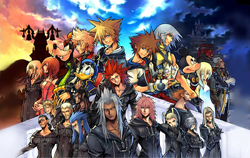
Kingdom Hearts features a mixture of familiar Disney and Square Enix characters, as well as several new characters designed and created by Nomura. Though the series features locations unique to the Kingdom Hearts franchise, worlds from Disney films are heavily explored. Sora must visit these worlds and interact with popular Disney characters to protect them from enemies. Often, Sora's actions in these worlds follow closely to the storylines featured in their accompanying Disney films. In dialogue, Donald Duck tells Sora not to interfere with the world too much, since it would cause problems. Moogles, small creatures from Final Fantasy, are another common element in the games. They allow the player to buy and sell items that they will need during the story, and provide the player with a synthesis shop to create items for use in the game. So far, twenty-one characters from the Final Fantasy series have appeared in the Kingdom Hearts games. The main cast from The World Ends with You also makes an appearance in the series as seen in Dream Drop Distance.
Story
Dark Seeker Saga
The Dark Seeker Saga, informally known as the Xehanort Saga, refers to the phase of the series that details the conflict against Xehanort and his various incarnations. Kingdom Hearts III concluded the saga, meaning later games will start a new one.
The Keyblade War and Xehanort's Interest
Many years ago, people thought that light was from Kingdom Hearts. It was guarded by the χ-blade. Many people made Keyblades in honor of the X-blade. The war broke the X-blade into twenty pieces: Seven of light and thirteen of darkness. The hearts of children helped reawaken the world while Kingdom Hearts was swallowed by darkness. Xehanort, from Destiny Islands, wanted to leave it because it was too small. He was contacted by his future Heartless to find 12 versions of himself in the future. Back in the present, Xehanort escaped to the Land of Departure. He wore Keyblade Armor until he wore a black cloak since he thought the armor would not accept the darkness.
The Origins of Sora and Xehanort
Three Keyblade apprentices, Terra, Aqua, and Ventus, train under Master Eraqus to become Keyblade Masters sometime. However, one day, a Keyblade Master, Xehanort, mysteriously disappears, and at the same time, a vicious species known as the Unversed begin spreading throughout the worlds. Terra is sent to defeat the Unversed and locate Master Xehanort. Ventus is goaded into following Terra by Master Xehanort's enigmatic apprentice, Vanitas, and Aqua is instructed by Master Eraqus to bring Ventus back home. Along the way, Terra slowly begins to lose control in the darkness inside his heart, but finds solace with Master Xehanort, who appears to understand him.
Terra crosses paths with a young boy named Riku and chooses him as his successor. Ventus befriends fellow Keyblade apprentice, Mickey Mouse, and crosses paths several times with Vanitas and eventually learns that Vanitas is the embodiment of the darkness inside him, extracted by Master Xehanort as part of his plan to forge the legendary χ-blade, capable of unlocking Kingdom Hearts itself. Ventus confronts Master Eraqus about this, who attempts to destroy him to stop the χ-blade's creation, but falls at the hands of Terra and Master Xehanort, the latter whom reveals his true intentions afterward.
Terra, Aqua, and Ventus eventually battle both Master Xehanort and Vanitas in the Keyblade Graveyard, where they each meet their fates: Terra is possessed by Master Xehanort and transformed into the new Xehanort, but the new Xehanort is defeated by the Lingering Will, Terra's armor animated by his lost mind; Ventus is possessed by Vanitas, but he, Mickey, and Aqua fight Vanitas together, Ventus mentally, and Aqua and Mickey physically, but though they manage to destroy Vanitas, the χ-blade and wipe the Unversed from existence, Ventus' heart is damaged and eventually makes contact with the heart of a young boy named Sora, merging with it; Aqua places Ventus' now-comatose body to rest inside Castle Oblivion, and while looking for Terra, finds Xehanort in the Radiant Garden, where he was sent following the χ-blade's destruction, and battles him in an attempt to rescue Terra. During the ensuing fight, Terra temporarily regains control of his body, but Master Xehanort quickly retakes control and attempts to force Terra's heart out of the body, but darkness spills forth and Xehanort starts to vanish.
As Xehanort begins to sink into the Realm of Darkness, Aqua follows and sacrifices her armor and Keyblade to save Terra's body while she remains in the darkness. Xehanort, now with amnesia, is found by the sage king of Radiant Garden, Ansem the Wise, and taken in as his apprentice. Mickey passes his Mark of Mastery Exam under his master, Yen Sid, and is awarded the title of Keyblade Master. Inside Xehanort, Terra continues to counter Master Xehanort, vowing not to stop until he has foiled Master Xehanort and expelled him from his body.
Sora's Journey Begins
Ten years later, the story focus shifts to Sora, Riku, and their friend, Kairi. The first game shows how Sora is separated from his friends when their world, Destiny Islands, is invaded by creatures known as the Heartless. During the invasion, Sora obtains the Keyblade, as Ventus's heart is still within him. Soon after finding himself in Traverse Town, Sora meets Donald Duck and Goofy, two emissaries from Disney Castle searching for the "key" per instructions from Mickey, their King. The three band together and travel to different Disney-themed worlds, sealing the Keyholes to the hearts of the worlds to prevent more Heartless invasions.
Along the way, they encounter a group of Disney villains, led by Maleficent, who is controlling the Heartless. Though they eventually defeat Maleficent, the three discover that Ansem, who has succumbed to the darkness, is the true mastermind. Ansem's plan is to open the door to "Kingdom Hearts", a door that holds the hearts of all worlds, in the hopes of attaining eternal darkness. Sora, Donald, and Goofy defeat Ansem and seal the door with the help of Riku and King Mickey on the other side of the door.
After sealing the door to Kingdom Hearts, Sora, Donald, and Goofy begin searching for Riku and King Mickey, finding themselves heading towards a mysterious fortress called Castle Oblivion. Upon entering the fortress, they begin to lose their memories. The three encounter a group of dark hooded villains (Marluxia, Larxene, Axel, and Vexen), part of a mysterious Organization. In the castle, Sora learns his memories have been manipulated by a girl named Naminé who was being held captive by the Organization. Sora, Donald, and Goofy fight their way through Castle Oblivion and eventually encounter and destroy Marluxia, the lord of the castle, thus freeing Naminé from his grip.
To allow them to regain their memories, Naminé puts Sora, Donald, and Goofy to sleep for a year; in the process, they must lose the memories of their experience in Castle Oblivion. At the same time, Riku finds himself in the basement of the castle and begins traveling to the first floor with the aid of King Mickey. Riku fights both the Organization's members (Vexen, Lexaeus, and Zexion) and the darkness in his heart, particularly the remains of Ansem, learning to accept his dual nature between light and dark. Allying himself with the mysterious DiZ, Riku aids him in keeping Sora and Naminé until the former is awakened. However, a snag in the plan over the year forces Riku to go after a young man named Roxas, the thirteenth member of the Organization to enable Sora's reawakening. Roxas, who had defected from the Organization earlier on after doubting their true motives and desiring to meet Sora in person, encounters Riku and defeats him easily at first, but Riku succumbs to the Darkness inside him and takes on the appearance of Ansem. With his newfound power, Riku subdues Roxas and takes him to DiZ, but the ordeal leaves him stuck in Ansem's form. With their plan successful, DiZ orders Riku to eliminate Naminé, but Riku refuses and instead lets Naminé go with Axel, who turned on Marluxia and chose to aid Sora in Castle Oblivion and who was Roxas's best friend.
Xehanort Revealed
Seven days after Riku's success, Sora, Donald, and Goofy awaken in Twilight Town, with no memory of their time at Castle Oblivion, and resume their search for Riku and King Mickey. They learn of the Nobodies and are re-familiarized with their leaders, Organization XIII (Xemnas, Xigbar, Xaldin, Saïx, Luxord, Roxas, and Demyx). Afterward, Maleficent is resurrected and joins with Pete, another Disney villain, to find a new base of operations before resuming her quest for power and revenge on Sora. Sora once again travels to many Disney-themed worlds and resolves the troubles caused by not just Maleficent and Pete, but also Organization XIII whose members refer to him as Roxas. Meanwhile, Kairi is kidnapped by the Organization. They meet King Mickey, who reveals that the "Ansem" Sora defeated was the Heartless of Xehanort, who, sometime after being found by Ansem, betrayed his master and stole his name, and since then, Ansem the Wise has been missing. Furthermore, they learn that Xemnas, the leader of the Organization, is the Nobody of Xehanort.
The three arrive at the headquarters of Organization XIII, The World That Never Was, with their own artificial Kingdom Hearts looming overhead, crafted from all the Heartless Sora has defeated, with Sora defeating all the Organization members as he is finally reunited with Kairi and Riku, who reveals Roxas as Sora's Nobody (as well as Naminé as the Nobody of Kairi) that he captured by willingly assuming the form of Ansem so that Roxas could be defeated and absorbed back into Sora. While this occurs, Mickey finds DiZ, revealed to be a disguised Ansem the Wise, with a device to digitize some of Kingdom Hearts' power; as the others arrive, the system overload causes the machine to explode with Ansem consumed in the blast, apparently killing him, with Riku restored to his original state. At the top of the castle, Sora and his friends battle Xemnas, who uses the remnants of Kingdom Hearts to fight them. Refusing to accept defeat, Xemnas separates Sora and Riku from the others to fight them in a final battle that ends with his demise. Though trapped on the other side, Sora and Riku can return to their world, via the Door to Light, which was mysteriously triggered from Sora's heart.
The Key that Connects Everything
With the threat of the Heartless and Nobodies over, Mickey, Donald and Goofy return to Disney Castle, where they stumble across a mysterious message written in Jiminy Cricket's Journal, "We must return to free them from their torment". Mickey digitizes the journal and creates a Sora made from Data to uncover the mystery. Following the journal's debugging, Mickey and Data-Sora find the source of the sentence: it was a message from Naminé, who integrated a data version of herself into the journal to inform Sora that he is the "Key that connects everything", and he has to save those connected to his heart from their suffering, namely the real Naminé, Roxas, Xion (a replica of Roxas created by Xemnas as a fail-safe in case Roxas or Sora proved useless to the Organization), and Axel, as well as Terra, Aqua, and Ventus. Mickey sends Sora a bottled letter about this.
Back in the Realm of Darkness, Aqua stumbles across Ansem, who survived the explosion of the Kingdom Hearts Encoder, which sent him there. Ansem, with few of his memories remaining, fills Aqua in about his experiences with Sora, which brings Aqua to tears of joy, knowing Sora will come and rescue her and her friends. On Destiny Islands, Sora decides to venture out to find and rescue his predecessors from their fates.
However, after successfully locating Aqua and Ventus's heart (thus leaving only Terra to be found), Mickey also receives the shocking news from Yen Sid that the destruction of Ansem and Xemnas has led to the return of Xehanort, and this will eventually bring back Master Xehanort. Seeing as Mickey alone is not enough to defeat what is not "a single one of [Xehanort]", Yen Sid orders Mickey to summon Sora and Riku to him to undertake a Mark of Mastery Exam to properly prepare them for their imminent clash with Master Xehanort.
The Return of Master Xehanort
Sora and Riku answer Yen Sid's call and he explains to them the details concerning Master Xehanort's rise and fall into darkness. Though Sora initially believes himself to be capable of beating Master Xehanort without becoming a Master, Riku readily agrees, to prove himself worthy of wielding the Keyblade, which makes Sora accept as well. Yen Sid assigns them to enter the Sleeping Worlds, where they are to locate and awaken seven worlds which were revived following Ansem's defeat, but remained submerged in sleep, and in the process unlock the Keyhole of Sleep. If they are successful, they will be deemed Keyblade Masters.
But along the way, Sora and Riku become separated and each end up encountering a mysterious young man in a black coat with ties to Master Xehanort and accompanied by Ansem, Xemnas, and Vanitas, whom they believed to have been defeated long ago. Ultimately, Sora's journey leads him to the World That Never Was instead of the Realm of Light, where he meets up with Xigbar and the young man himself, who reveals that he is Master Xehanort in his youth from the past, who was paid a visit via time travel by the disembodied Ansem, who sent him on a mission to travel to different periods to gather various incarnations of Xehanort to build the real Organization XIII. Sora fights his way to the castle, but is intercepted by Xemnas and ends up with his heart damaged, whereupon he falls into a coma and is taken to the castle by Young Xehanort.
Riku tracks Sora to the World That Never Was and finds him in the castle, where he battles and manages to defeat Young Xehanort with help from Mickey. Following the fight, Master Xehanort is finally revived and reveals his true intentions: following his failure to use the X-Blade to summon Kingdom Hearts by pitting a heart of pure light against a heart of pure darkness, he has learned an alternate way of creating the X-Blade, since years before, after the Keyblade War, the X-Blade was shattered into thirteen darknesses and seven lights, and if Master Xehanort creates an Organization out of thirteen incarnations of himself, he will be able to recreate the X-Blade and start another Keyblade War. As Master Xehanort moves in to turn Sora into the thirteenth and final vessel for the Organization, Lea, Donald, and Goofy arrive to aid Riku and Mickey, and Master Xehanort is forced to retreat with Young Xehanort, Ansem, Xemnas, Xigbar, Saïx, and his six hooded vessels.
Riku brings Sora's comatose body back to Yen Sid, where he dives into Sora's Dive to the Heart and collects the fragments of Sora's shattered heart, in the process battling a corrupted Sora himself and winning. Riku succeeds in waking Sora up, but Yen Sid only names Riku as a Keyblade Master for his efforts. Sora, undaunted by his failure, congratulates Riku and departs to continue his training elsewhere. Lea, meanwhile, shocks everybody present by summoning his own Keyblade, something he had only recently mastered and was unable to use against the Organization.
With the knowledge of Master Xehanort's plans, Yen Sid orders Riku to bring Kairi to him so that she may undergo training with her Keyblade and become their seventh light to counter Master Xehanort's Organization XIII.
The Final Battle
Sora, Riku, and Mickey traveled across the worlds in the search for the lost Keyblade warriors, as well as finding a way to bring back the lost heroes such as Xion and Naminé, while at the same time liberate worlds from the works of Organization XIII. Kairi and Lea trained in a world where they could train as much as they like.
Riku and Mickey managed to have found Aqua, but she was corrupted by the darkness, and so she fought the Keyblade masters. Sora arrived and was able to save them all. Aqua and Sora visited Castle Oblivion, where they converted it back into being the Land of Departure, to wake up Ventus. With the Seven Guardian of Light united, consisting of Sora, Riku, Mickey, Kairi, Lea, Aqua, and Ventus, they were prepared to face Xehanort and the Thirteen Seekers of Darkness.
As they arrived to the Keyblade Graveyard, the heroes were all wiped out by hordes of darkness. Sora was taken to the Final World, a limbo world where he managed to have survived. Sora was able to use the power of waking to save all of his friends, where they would be properly prepared to face off against the enemy. However, unknown to Sora, his usage of the power of waking had disrupted the Master of Masters' prophecy written in the Book of Prophecies about the Second Keyblade War, and there would be a heavy price to pay for altering destiny and the outcome of the Second Keyblade War.
As the clash between good and evil prevailed, the Guardians of Light were able to defeat twelve of the Thirteen Seekers of Darkness, while at the same time rescued other heroes such as Roxas, Xion, and Terra. Sora faced Master Xehanort himself, who had struck Kairi down into nothing. Xehanort was able to forge the X-blade and prepared to use Kingdom Hearts to destroy the worlds to free them from Darkness. The Guardians of Light were able to transport Xehanort into Scala ad Caelum, where Sora entered to defeat the villain once and for all.
After a final battle, Xehanort was defeated and Sora was able to close Kingdom Hearts for good. While most of the heroes prevailed, Sora knew he had to bring back Kairi. So he used the power of waking to find Kairi and bring her back home. So the heroes celebrated their victory, with a revived Naminé and Isa, on Destiny Islands, where they witnessed Sora bringing back Kairi, but the hero vanished out of existence, due to overusing the power of waking and violating the Master of Masters and Book of Prophecies.
Epilogue
Xigbar, having revealed to have survived the battle, summoned the Foretellers from the first Keyblade War. He is revealed to have been Luxu all along. He is seen with the Black Box.
The Lost Master Arc
Development
History
The initial idea for Kingdom Hearts began with a discussion between Shinji Hashimoto and Hironobu Sakaguchi about Super Mario 64. They were planning to make a game with freedom of movement in three dimensions like Super Mario 64, but lamented that only characters as popular as Disney's could rival a Mario game. Tetsuya Nomura, overhearing their conversation, volunteered to lead the project and the two producers agreed to let him direct. A chance meeting between Hashimoto and a Disney executive in an elevator—Square and Disney had previously worked in the same building in Japan—allowed Hashimoto to pitch the idea directly to Disney. The first Kingdom Hearts began development in February 2000. It was directed by Tetsuya Nomura and produced by Shinji Hashimoto, who had conceived the idea when he met with a Disney executive in an elevator. Square and Disney had previously worked in the same building in Japan. While Nomura had done previous work in the Final Fantasy series as a monster designer and graphic director, he did not gain widespread recognition until he was the lead character designer for Final Fantasy VII. Kingdom Hearts marked his transition into a directional position. He also served as the game's character designer. The scenarios were provided by Kazushige Nojima who was a scenario writer for Square from Final Fantasy VII until he left Square Enix in 2003. Originally the development focused on the gameplay with a simple story to appeal to Disney's target age range. After Kingdom Hearts executive producer Hironobu Sakaguchi told Nomura that the game would be a failure if it did not aim for the same level as the Final Fantasy series, he began to develop the story further. In June 2013, Nomura stated the name of the game came from him thinking about Disney Theme Parks, especially Animal Kingdom. However, Nomura could not get the IP with just "Kingdom", so the development team began to think about "heart" as a core part of the story, so they decided to combine the two to form "Kingdom Hearts".
Nomura placed an unlockable trailer in Kingdom Hearts in hopes that fans would want a sequel. He was unsure if fans would want a sequel and felt that if they did not, then it would be best to leave certain events in the first game unexplained. After Kingdom Hearts Final Mix was completed, development for Kingdom Hearts II began. Nomura has stated that there were several obstacles to clear before development could begin on a sequel. One was the development team's desire to showcase Mickey Mouse more; Nomura had planned for the sequel to take place a year after the first and originally intended for the events of that year to be left unexplained. To bridge the gap between the two games, Kingdom Hearts: Chain of Memories was developed. Nomura was hesitant about releasing a game on the Game Boy Advance because he felt that the 3D graphics of the original game would not translate well into 2D. Nomura changed his position after hearing that children wanted to play Kingdom Hearts on the GBA.
Creation and design
Director Tetsuya Nomura also worked as the character designer of the games. Though Disney gave Nomura freedom in the characters and worlds used for the games, he and his staff tried to stay within the established roles of characters and boundaries of the worlds. Nomura has stated that though many of the Disney characters are not normally dark and serious, there were not many challenges making them so for the story, and despite this, their personalities shine because they maintain their characteristics. When deciding which worlds to include in the game, the development staff tried to take into account worlds with Disney characters that would be interesting and made an effort to minimize any overlap in the overall look and feel of each world.
The inclusion of specific Final Fantasy characters was based on the opinions of both fans and staff. Another criteria for inclusion was whether the staff felt the characters would fit into the storyline and in the Kingdom Hearts universe. Initially, Nomura was hesitant to use characters he did not design because he was unfamiliar with the background work of those characters. For Kingdom Hearts II, he changed his mind after receiving pressure from his staff. Throughout the development of the games, Nomura has often left certain events and connections between characters unexplained until the release of future games. Nomura did this because he feels that games should have room for fans to speculate and use their imagination. He stated that with speculation, even though a game gets old, people can still be happy with it.
Promotion
The first Kingdom Hearts was announced at E3 in May 2001. Initial details were that it would be a collaboration between Square and Disney Interactive and would feature worlds developed by both companies and Disney characters. New characters were designed by Nomura and include Sora, Riku, Kairi, and the Heartless. On May 14, 2002, a press release announced a list of the English voice actors. The list included Haley Joel Osment, David Gallagher, and Hayden Panettiere as the three new characters introduced in the game. It was also announced that many of the Disney characters would be voiced by their original voice actors from their respective Disney films.
An unlockable trailer in the first Kingdom Hearts and Kingdom Hearts Final Mix hinted at the possibility of a sequel. Rumors for a sequel on the PlayStation 2 were spurred in Japan when the Japanese video game site, Quiter, stated that "an internal (and anonymous source) at Square Japan" confirmed that development of Kingdom Hearts II had begun. It was not until Kingdom Hearts II was announced, along with Kingdom Hearts: Chain of Memories, at the Tokyo Game Show in September 2003 that rumors were confirmed. Initial details were that it would take place sometime after Kingdom Hearts: Chain of Memories, which takes place directly after the first game. Other details included the return of Sora, Donald, and Goofy, as well as new costumes. At the 2004 Square Enix E3 Press conference, the producer, Shinji Hashimoto, stated that many mysteries of the first game would be answered.
To help market the games, websites were set up for each game and demos were on display at gaming events. Each game in the main series was also re-released in Japan with additional content and served as canonical updates to the series. The additional content foreshadowed later plot elements in the series. The re-releases of the main series games had the term "Final Mix" added after the title, while Kingdom Hearts: Chain of Memories was re-released as Kingdom Hearts Re:Chain of Memories and released on the PlayStation 2 with 3D graphics, voice-overs during some cutscenes, as well as additional game content.
Creation and Influence
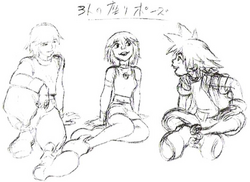
Early sketch of Riku, Sora, and Kairi.
The Kingdom Hearts series is directed by Tetsuya Nomura, who also works as the character designer of the games. Nomura has stated that unlike working with Final Fantasy characters, keeping the main character Sora alive and interesting over multiple games is a challenge. He has also stated that though many of the Disney characters are not normally dark and serious, there were not many challenges making them so for the story, and despite this, their personalities shine because they maintain their characteristics. Though Disney gave Nomura freedom in the characters and worlds used for the games, he and his staff tried to stay within the established roles of characters and boundaries of the worlds. When deciding which worlds to include in the game, the development staff tried to take into account worlds with Disney characters that would be interesting.
The inclusion of specific Final Fantasy characters was based on the opinions of fans and the development staff. Another criteria for inclusion was whether the staff felt the characters would fit into the storyline and in the Kingdom Hearts universe. Initially, Nomura was hesitant to use characters he did not design because he was unfamiliar with the background work of such characters. For Kingdom Hearts II, he changed his mind after receiving pressure from his staff. Throughout the development of the games, Nomura has often left certain events and connections between characters unexplained until the release of future games. Nomura did this because he feels that games should have room for fans to speculate and use their imagination. He stated that with speculation, even though a game gets old, people can still be happy with it. As of Kingdom Hearts 3D: Dream Drop Distance, Tetsuya Nomura has begun to introduce characters from Square Enix's other produced game series, specifically The World Ends With You.
Audio
Musical score
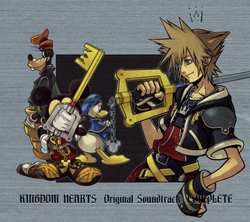
Cover of the Kingdom Hearts Original Soundtrack Complete.
The music for the video game series was primarily composed by Yoko Shimomura. Kaoru Wada works as the arranger for orchestral music in the Kingdom Hearts series, including orchestral renditions of the main vocal themes and the ending themes. The orchestral music was performed by the New Japan Philharmonic Orchestra and the Tokyo Philharmonic Orchestra. Soundtracks were released for the first and third installments following the release of their respective games. A compilation soundtrack was later released that included soundtracks for the entire series, including reworked tracks for the re-released Kingdom Hearts Re:Chain of Memories.
While the themes for some of the Disney-based worlds are taken directly from their Disney film counterparts, most of them are given entirely original musical scores. In addition to each world having unique background music, each is given its battle theme rather than having a common theme to cover all fights. Several of the Disney villains get themes based on the film from which they originated, and the final boss of each game has several themes played in the various phases of those fights. The fights with Sephiroth feature Nobuo Uematsu's One-Winged Angel from Final Fantasy VII.
The main theme songs for the Kingdom Hearts games were written and performed by Japanese pop star, Utada Hikaru. The two main themes are Hikari, from Kingdom Hearts, Chain of Memories, Birth by Sleep and re:coded" and Passion, from Kingdom Hearts II and 385/2 Days. Each song had an English counterpart, Simple and Clean and Sanctuary respectively, for the North American, Final Mix and European releases. Utada was the only singer Tetsuya Nomura had in mind for the first Kingdom Hearts theme song. This marked the first time Utada had produced a song for a video game. Both theme songs reached notable popularity in Japan. On weekly Oricon charts, Hikari hit #1 in 2002 and Passion hit #4 in 2005.
Voice cast
The Kingdom Hearts games featured well-known voice actors for both the Japanese and English versions. The Japanese version featured Miyu Irino as Sora, Risa Uchida as Kairi, and Mamoru Miyano as Riku. The third game introduced Kōki Uchiyama as Roxas, Iku Nakahara as Naminé, and Genzō Wakayama as DiZ. Other notable voice actors included Kōichi Yamadera, Hideo Ishikawa, Maaya Sakamoto, Takahiro Sakurai, Akio Ōtsuka, Takashi Aoyagi, Yū Shimaka, and Shinichirō Miki.
The English release of the Kingdom Hearts games featured an all-star voice cast which included many of the Disney characters' original voice actors. Wayne Allwine (and later Bret Iwan due to Allwine's death), Tony Anselmo, and Bill Farmer voiced Mickey Mouse, Donald Duck, and Goofy. Several high profile actors provided the voice acting of the main characters. The first game featured Haley Joel Osment as Sora, David Gallagher as Riku, and Hayden Panettiere as Kairi. The third game saw the return of the main character voice actors and added Jesse McCartney as Ventus and Roxas, Brittany Snow as Naminé, and Christopher Lee as Ansem the Wise. Other notable actors included Steve Burton, Mandy Moore, David Boreanaz, Ming-Na Wen, and James Woods and most recently, Jason Dohring, Willa Holland, Leonard Nimoy, and Mark Hamill.
Disney Properties
Mickey Mouse & Friends – Mickey Mouse Works - Mickey Mouse, Minnie Mouse, Donald Duck, Goofy, Daisy Duck, Pluto, Chip and Dale, Clarabelle Cow, Horace Horsecollar, Clara Cluck, Scrooge McDuck, Huey, Dewey, and Louie, and Pete
Disney Animated Features Canon
Pixar
| Film | World(s) | Featured Characters | Games Appeared In |
| Toy Story | Toy Box | Woody, Buzz Lightyear, Rex, Hamm, Sarge, Green Army Men, and Aliens | Kingdom Hearts III KH: Melody of Memory |
| Monsters, Inc. | Monstropolis | James P. Sullivan, Mike Wazowski, Boo, Randall Boggs, and CDA | Kingdom Hearts III KH: Melody of Memory |
| Ratatouille | N/A | Remy | Kingdom Hearts III |
Disneytoon Studios
- The Return of Jafar
- Stitch! The Movie (Experiment 221 only)
- Mickey, Donald, Goofy: The Three Musketeers
- Pooh's Heffalump Movie (Lumpy only)
Other animated films
| Film | World(s) | Featured Characters | Games Appeared In |
| The Nightmare Before Christmas | Halloween Town/Christmas Town | Jack Skellington, Sally, The Mayor, Zero, Oogie Boogie, Dr. Finkelstein, Santa Claus, Elves, Lock, Shock, and Barrel | Kingdom Hearts KH: Chain of Memories Kingdom Hearts IIKingdom Hearts 358/2 Days KH: Melody of Memory |
Shorts
of the main Kingdom Hearts games. They each had a release in Japan, North America, and the PAL region. They were also re-released in Japan with new content. Both Square and Disney also released numerous types of merchandise before and after the release of the game. Merchandise ranged from toys and figurines to clothing items and jewelry. Two of the games, Kingdom Hearts and Kingdom Hearts II had a soundtrack released around the same time as the video games. These were followed by a nine CD complete set.
Live-Action films
| Film | World(s) | Featured Characters | Games Appeared In |
| Tron | Space Paranoids | Tron, Master Control Program, and Sark | Kingdom Hearts II KH: Melody of Memory |
| Pirates of the Caribbean: The Curse of the Black Pearl/Pirates of the Caribbean: At World's End | Port Royal/Caribbean | Jack Sparrow, Will Turner, Elizabeth Swann, Captain Barbossa, Undead Pirates,
Mr. Gibbs, Tia Dalma, Davy Jones, Kraken, and Cutler Beckett |
Kingdom Hearts II Kingdom Hearts III |
| Tron: Legacy | The Grid | Sam Flynn, Quorra, Kevin Flynn, CLU, Rinzler, and Black Guards | KH 3D: Dream Drop Distance KH: Melody of Memory |
Theme Park Attractions
- Main Street Electrical Parade
- Sailing Ship Columbia
- Big Thunder Mountain Railroad
- Mad Tea Party
- Buzz Lightyear Astro Blasters
- Grizzly River Run
- King Arthur Carrousel
Merchandise
There are multiple versions of each of the main Kingdom Hearts games. They each had a release in Japan, North America, and the PAL region. They were also re-released in Japan with new content. Both Square and Disney also released numerous types of merchandise before and after the release of the game. Merchandise ranged from toys and figurines to clothing items and jewelry. Two of the games, Kingdom Hearts and Kingdom Hearts II had a soundtrack released around the same time as the video games. These were followed by a nine CD complete set that featured both soundtracks and unreleased tracks. Kingdom Hearts has also been published as a trading card game by the Tomy corporation of Japan. An English version of the game was released in November 2007 by Fantasy Flight Games. The video games have also been adapted into a manga and novel series.
Like the Final Fantasy games, a series of Ultimania books were also released in Japan for the three main games. There are six books which include game walkthroughs, interviews, and extra information from the developers. The books include Kingdom Hearts Ultimania, Kingdom Hearts Ultimania Revised Edition, Kingdom Hearts: Chain of Memories Ultimania, Kingdom Hearts Series Ultimania α ~Introduction of Kingdom Hearts II~, Kingdom Hearts II Ultimania, and Kingdom Hearts II Final Mix+ Ultimania. Released along with Kingdom Hearts II Final Mix+ was Kingdom Hearts -Another Report-, a hardback book which includes game information, visuals by Shiro Amano, and a director interview. In North America, Brady Games released strategy guides for each game. For Kingdom Hearts II, they released two versions, a standard version and a limited edition version. The limited-edition was available in four different covers and included a copy of Jiminy's Journal along with 400 stickers.
Printed adaptations
A manga based on the Kingdom Hearts storyline has been released in Japan and the United States. The story and art are done by Shiro Amano, who is also known for his manga adaptation of the Legend of Mana video game. The story follows the events that took place in the video games with differences to account for the loss of interactivity a video game provides. The manga was originally serialized in Japan by Square Enix's Monthly Shonen Gangan and eventually released in tankōbons. The first tankōbon was released in Japan in October 2003. The manga was released in the USA by Tokyopop two years later in October 2005. It was divided up into three manga series based on Kingdom Hearts, Kingdom Hearts: Chain of Memories and Kingdom Hearts II. The first series, Kingdom Hearts, was broken up into four volumes, while the second series, Kingdom Hearts: Chain of Memories, was broken up into two volumes. The third series, Kingdom Hearts II, is currently still being serialized. The first volume was released in Japan in December 2006 and was released in the USA on July 3, 2007.
A novel series has also been released. It is written by Tomoco Kanemaki and illustrated by Shiro Amano. Like the manga series, it is divided up into separate series based on the games. Kingdom Hearts is divided up into two volumes; "The First Door" and "Darkness Within". They are scheduled to be released in the USA in June 2008. Kingdom Hearts: Chain of Memories has currently been released only in Japan and is divided into three volumes. Kingdom Hearts II has also been released only in Japan and is divided into four volumes; "Roxas - Seven Days", "The Destruction of Hollow Bastion", "Tears of Nobody", and "Anthem-Meet Again/Axel Last Stand".
Reception
The Kingdom Hearts series has been critically and commercially successful, though each installment has seen different levels of success. By December 2005, the Kingdom Hearts series had shipped more than 8.5 million copies worldwide. As of September 2007, the series has shipped over eleven million copies worldwide, with 2.0 million copies in PAL regions, 3.0 million copies in Japan, and 5.6 million copies in North America. The three main games in the series all met with positive sales at the time of their releases. During the first two months of Kingdom Hearts's North American release, it was one of the top three highest-selling video games. Chain of Memories sold 104,000 units in 48 hours in Japan, a record for a Game Boy Advance title at the time. Its positive debut sales placed it in the top spot of sales charts in Japan. In the first month of its North American release, it was ranked 1st on GameSpot's ChartSpot for portable systems and 6th for all consoles. Within a week of Kingdom Hearts II's Japanese release, it shipped 1 million copies, selling almost 730,000 copies. By the end of March 2006, the NPD Group reported that Kingdom Hearts II was the highest-selling console game in North America, with 614,000 copies. In the month after its release in North America, Kingdom Hearts II sold an estimated 1 million copies.
The games have also received high ratings and positive comments from reviewers. The three main games have scored a 36 out of 40 or higher from the Japanese game magazine Famitsu, known for its extremely harsh grading. All four games have been praised for their visuals. The games have also won several awards. GameSpot commented that the concept of mixing the serious elements of Final Fantasy with the lighter elements of Disney seemed impossible, but was pulled off quite well. Because of that, they awarded Kingdom Hearts "Best Crossover Since Capcom vs. SNK" in their 2002 Best and Worst of the Year awards. IGN named Kingdom Hearts "Best Art Style/Direction" in their 2003 list of "Best Looking Games on PS2". G4 awarded it "Best Story" at their 2003 G-Phoria awards show. The manga series has also been well received. Several of the manga volumes were listed on USA Today's "Top 150 best sellers". The highest-ranked volume was Kingdom Hearts volume 4 at #73. Every volume listed stayed on the list for at least two weeks; Kingdom Hearts volume 4 stayed the longest at four weeks.
The series overall has been very well received by critics and fans, heavily praising the games' gorgeous visuals, solid gameplay, and faithfulness to the original Disney source material. Despite this, some fans have criticized the overarching plot trough out the series to be too complicated and convoluted.
Copyright Information
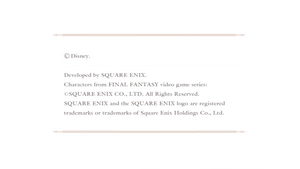
Copyright information during startup of Kingdom Hearts HD ReMixes, indicating that the ownership of the series belongs to Disney.
- “A lot of people are confused about who exactly owns Kingdom Hearts, but it's Disney - it's developed in partnership with Square-Enix.”
- ―John Vignocchi during D23 2015[[src]]
The series' legal ownership has long been debated amongst fans; this is because the game features Disney characters, but is created and primarily promoted by Square Enix, as well as featuring cameos by characters from the latter's franchises.
Square Enix only takes credit for developing and publishing the games, not owning them. Following this will be a series of copyright laws containing SE's Ownership of the FF Characters and FF Music used in the games. Square Enix does not own the Kingdom Hearts games, nor its original characters. They take credit for making the games and owning the Final Fantasy Characters/Music used in said games.
The definitive response is that Square Enix only takes credit for developing and co-publishing the Kingdom Hearts series (similar to that of Castle of Illusion starring Mickey Mouse being developed by Sega and DuckTales being developed by Capcom), while Disney owns the series and all original characters and settings. Therefore, Sora, Riku, Kairi, Xehanort, Chirithy, the Organization XIII members, and so forth are solely owned by the Walt Disney Company.
This ownership is established in the title screen of each Kingdom Hearts entry. It has also been explained vocally by John Vignocchi, VP of Production for the Disney Infinity game series during an interview following D23 Expo 2015 (quoted above), in regards to Kingdom Hearts franchise characters' possible inclusion in Disney Infinity. He indicated that they consult Square Enix out of respect when considering using Kingdom Hearts elements. For instance, before the release of the King Mickey power-up disc, the Disney Infinity team had been in talks with Square Enix for 8 months, discussing ways to implement it while being "respectful to the brand"[4].
All Square Enix characters and elements (i.e. Final Fantasy and The World Ends With You characters) are still the sole property of Square Enix.
Along with Sora and all original characters owned solely by Disney, this also classifies them as Disney characters, having been created for a Disney game/Disney product.
Gallery
Videos
Trivia
- Thirteen is a recurring number throughout the series:
- It is primarily associated with Organization XIII and, by extension, Mushroom XIII, Finest Fantasy 13, and the thirteen floors of Castle Oblivion.
- The Director's Secret Report XIII is a thirteen-part exposé by Tetsuya Nomura.
- Riku's Session Limit includes an ability named "XIII Blades".
- There are thirteen letters in "Kingdom Hearts".
- Ars Arcanum consists of thirteen attacks if one includes the follow-up attacks.
- In Kingdom Hearts Birth by Sleep, not counting the additional ones presented in the Final Mix version, the Mirage Arena has thirteen matches.
- Thirteen Orichalcum+ are required to synthesize Ultima Weapon in Kingdom Hearts II.
- The sum of all the letters in the names Sora, Riku, and Kairi is thirteen. The same is true for Roxas, Sora, and Xion, and Roxas, Axel, and Xion.
- There are thirteen letters in "Terra-Xehanort" and "Ventus-Vanitas".
- In the opening FMV of Kingdom Hearts, the letter "M" in the word "Kingdom" surges towards the screen distinctly, with "M" being the thirteenth letter in the alphabet.
- Except for Coded, Kingdom Hearts 3D: Dream Drop Distance, and Kingdom Hearts: Melody of Memory in each major installment of the series, the final world is the thirteenth location the player can visit: in Kingdom Hearts, End of the World is the thirteenth world to be seen; in Kingdom Hearts II, The World That Never Was is the thirteenth world, not including 100 Acre Wood or Atlantica; in Kingdom Hearts Birth by Sleep, the Keyblade Graveyard is the thirteenth world if one counts the Destiny Islands; and in Kingdom Hearts III, Scala ad Caelum is the final world if one doesn't count Mysterious Tower and the Land of Departure.
- There are thirteen letters in "End of the World", "Hollow Bastion", and "Radiant Garden".
- In Kingdom Hearts coded, there is a System Sector in Hollow Bastion that contains thirteen floors.
- Sora is "Combatant thirteen" when he faces Rinzler in The Grid.
- In Kingdom Hearts 3D: Dream Drop Distance, there are thirteen Training Toy candies.
- Following the Keyblade War, the χ-blade is shattered into thirteen darknesses and seven lights.
- In Kingdom Hearts III, the box art has the thirteen protagonists all together.
- The number three is also a recurring theme:
- Three worlds (involved with the story) in the main games that are not based on Disney movies.
- Traverse Town, Hollow Bastion and End of the World (Kingdom Hearts)
- Twilight Town, Radiant Garden and The World That Never Was (Kingdom Hearts II)
- Twilight Town, the Dark World and Keyblade Graveyard (Kingdom Hearts III)
- Trios.
- Mickey, Donald, and Goofy; the Disney Trio
- Sora, Riku, and Kairi: the Destiny Trio
- Terra, Ventus, and Aqua: the Wayfinder Trio
- Roxas, Axel/Lea, and Xion; the Sea Salt Trio
- Hayner, Pence, and Ollete; the Twilight Town Trio
- Three opposing forces
- Xehanort's group
- Maleficent's group
- Independent villains
- Three realms of existence.
- The Realm of Light
- The Realm Between
- The Realm of Darkness/Dark World
- The final battle of each main game taking places in three phases:
- Ansem is fought at the remnants of Destiny Islands by Sora, Donald, and Goofy; isolates Sora for a second fight; summons the World of Chaos battleship in the third.
- Xemnas fights Sora, Donald, Goofy and Riku using the World of Nothingness battleship, isolates Sora and Riku from their friends in a bid to attack with it again; traps all three of them in literal nothingness in final attempt to slay them.
- Master Xehanort uses his replicas to wear down Sora, Donald, and Goofy; dons a new Keyblade armor, warping the world to help him fight; summons the X-blade in one final attempt to defeat Sora.
- Three different ways to pilot the Gummi ship.
- Three worlds (involved with the story) in the main games that are not based on Disney movies.
- There were many similarities between the games, trio groups and other characters throughout the series:
- "Birth By Sleep" and "Kingdom Hearts":
- They start with the same beginning; a the Dive to the Heart station or Station of Awakening for a main character of a trio and both being awoken from their slumber (Ventus and Sora).
- One of the trio members fell to darkness and yet both found their way out in later games (Terra and Riku).
- One of the trio members wandered around in the Realm of Darkness (Aqua and Riku).
- Had their hearts separated from their bodies but were sheltered by another (as both Ventus and Kairi had their hearts inside of Sora).
- Both Sora and Ventus recited the same line "My friends are my power" and both gave the same angry look to Braig/Xigbar.
- Both trios had their home worlds destroyed by Darkness (Destiny Islands by the heartless, the digital and real Daybreak Town destroyed by darkness and Land of Departure by Xehanort and before Aqua changed it to Castle Oblivion)
- Both Aqua and Sora recited the same line about the dark fate of their friends telling the antagonist to return their friends hearts.
- Sora, Ventus, and Xehanort each surrendered their hearts willingly but with different intentions (Sora's was to free Kairi, Ventus did it to save his friends and while Xehanort used Terra to continue with his plans).
- Both Kairi and Ventus didn't recall anything of their original worlds, left their worlds by using lifeboat pods and were found by someone at the end of their destinations.
- "Birth by Sleep" and "Kingdom Hearts II":
- Both Ventus and Sora's dark half didn't look like either of them but the other (the hearts of those who were connected to them.)
- "Birth by Sleep" and "Chain of Memories":
- After Ventus and Sora lost things that were important to them (Ventus's heart and Sora's memories) both were taken to places of safety until it could be reclaimed.
- "Dark Road" and "Kingdom Hearts III":
- Both Eraqus and Hoder merged their hearts with the protagonists of their games and became light apparitions later.
- The chains used to bind Baldr then Aqua, Ventus and Sora were same.
- "Kingdom Hearts" and "Dark Road":
- Both Riku and Xehanort used the power of Darkness to leave their homeworld.
- They were both intended to be the chosen ones of a prophecy, but they weren't.
- "Birth By Sleep" and "Kingdom Hearts II":
- Donald and Goofy were given guidance along with Sora by Yen Sid at his tower and decade ago they were with Ventus.
- "Dream Drop Distance" and "Kingdom Hearts III":
- The scene where Riku wakes up Sora's sleeping heart is similar to what Sora did for Ventus.
- "Birth By Sleep" and "Dream Drop Distance":
- Only one member of the trio obtains the rank of Master.
- "Kingdom Hearts" and "Melody of Memory":
- Both protagonists were left defenseless but defended themselves with help of a friend.
- "Birth By Sleep" and "Kingdom Hearts":
- Strangely enough, when 358/2 Days and Re:Coded is played on a Nintendo DSi, the DSi menu description of the game states that Square Enix is the sole publisher, despite being owned completely by Disney.
- Kingdom Hearts was not the first attempt at a partnership between Disney and Square Enix. There were plans for Disney to distribute a comic book based on Final Fantasy IV (made by Square Co., before it was merged with Enix), although the concept was dropped.
- During the Tokyo 2020/2021 Summer Olympic Games opening ceremonies Parade of Nations, the music from Olympus Coliseum could be heard alongside other video game music as the athletes marched into the Olympic Stadium.
References
- ↑ Kingdom Hearts: The Story So Far collects the entire saga on PS4
- ↑ KINGDOM HEARTS All-In-One Package
- ↑ @KINGDOMHEARTS: "The brand-new #KingdomHearts All-in-One Package is coming on #PS4 to North America on 3/17!"
- ↑ http://comicbook.com/2015/08/16/kingdom-hearts-comes-to-disney-infinity-at-d23-expo/
External links
 Kingdom Hearts (series) on Wikipedia
Kingdom Hearts (series) on Wikipedia- Official website
- Official website (JP)
- Disney's Kingdom Hearts site (JP)
- Kingdom Hearts Fandom
- KHWiki
 Kingdom Hearts (series) on Facebook
Kingdom Hearts (series) on Facebook Kingdom Hearts (series) on 𝕏
Kingdom Hearts (series) on 𝕏 Kingdom Hearts (series) on Instagram
Kingdom Hearts (series) on Instagram

